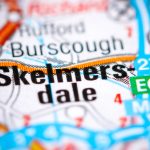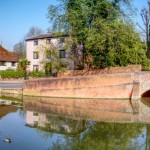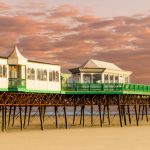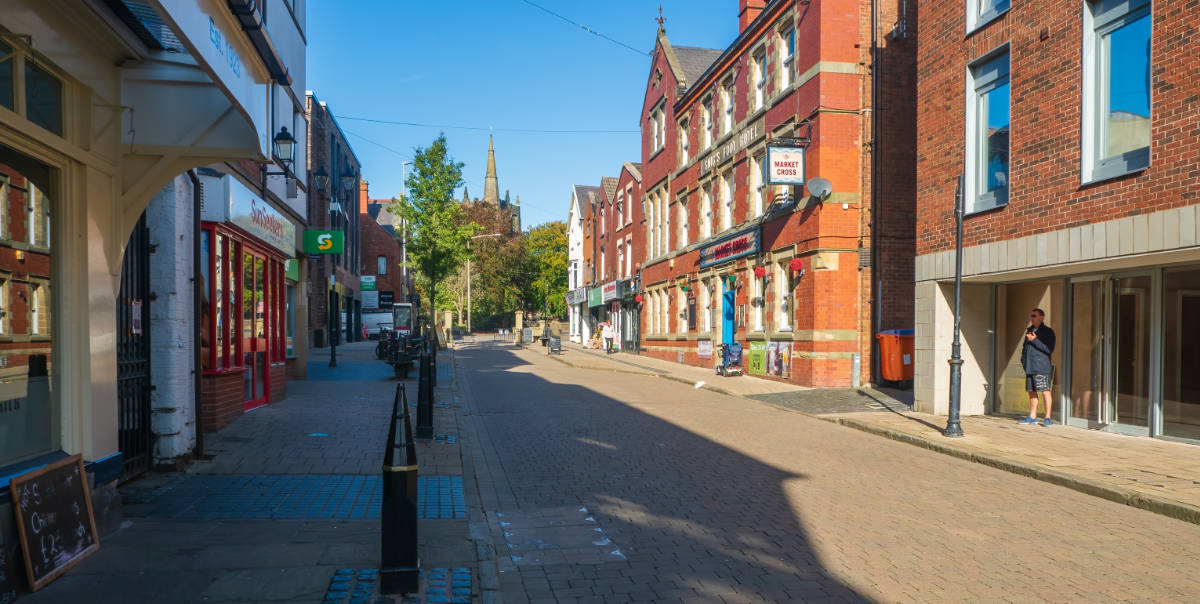
Want to know more about this Lancashire Jewel? It turns out that there is more to this town than gingerbread.
Ormskirk is a fascinating Lancashire town. It’s fascinating because of the records of how the townsfolk lived in the last few hundred years are detailed. Ormskirk is famous for gingerbread, but it has a longer history than that. It has an ancient marketplace, a Viking built it, and there was once a plethora of monks here. Want to learn more? We sure do. Here goes nothing.
The Early History of Ormskirk
According to the local historical society, Ormskirk began in 850, when a Viking chose to settle here. Some say he built a church. A Viking building a church in 850AD seems like a bit of a stretch to us. They were barely started their slow conversion to Christianity, and it seems like any churches built by Danes may well have been torched. However, that’s what the history books say so we won’t disagree. There were some Christian Danes, it’s the likelihood of building a whole church that is questionable.
Anyway, the story goes that Orm built a church, and the townsfolk called it Orm’s Kirk. Kirk is an exceptionally Scottish word to be so far south. It could be that it derives from Danish, rather than old English. Perhaps both. The Vikings had a profound impact on our dialect and tongue. Did you know that any ‘egg’ is a Viking word? Just saying.
Anyway… Orm had his kirk and people came to pray in it. Later, like 2 hundred years later, Burscough Priory opened nearby. Accounts say it was an impressive structure which Robert Fitzhenry de Lathom gifted. Robert Fitzhenry de Lathom was clearly one of the Norman invaders’ descendants. King William gave away parcels of land to the people who pleased him most, but that was in 1066.
Doomsday Book
Speaking of which, Ormskirk is old enough to be in the Domesday Book of 1086, even though Lancashire didn’t exist yet. In fact, the entire town is missing from the book. They sometimes skipped past those towns which had a huge population, or which were largely abandoned. It is a shame that we don’t know who owned it back then. However, a good guess would be Robert Fitzhenry de Lathom.
We should mention that a Roman road cut through this area around 4AD. It connected the Cheshire salt towns with London and the bigger cities. Metal detectorists have unearthed Roman coins around Slack Farm. Asides from that, the name of the town is definitively Scandinavian, which places its beginnings around 800AD.
The Black Death made its first appearance in Ormskirk in 1359. This is about a hundred years after the first market appeared in Ormskirk.
Medieval Era
The market at Ormskirk received its charter in 1286 when the monks from Burscough set up a trading place. Now the pride and joy of the town, the market makes Ormskirk a little bit famous. Why? It is still running today, 700-and-something years later.
In 1435, the church added a spire to the Ormskirk. In 1496, the local manor Lathom House became the biggest and best in the country. Henry VII visited it that same year. He toured the area and loved it so much that his successor and namesake, Henry VIII, dissolved the monasteries and closed the priory at Ormskirk in 1539. Sounds like a messed up family.
By 1600, the town was nothing but a small group of buildings around the cross. Nevertheless, they gained a grammar school in 1614. James I passed through the cross in 1617, stayed at Lathom House, and went on to take the throne. Not bad for a day’s work.
In 1644/5, Lathom House suffered a siege by the Parliamentarians. The Royalist occupants lost the battle in 1646 when the house was razed to the ground. In 1648, the Earl of Derby died fighting the Parliamentarians. He is buried on the Ormskirk Parish Church grounds. The Countess of Derby later visited and gifted the church a font, so the family must have been visitors to the church here.
By 1635, leather goods were fashioned in Ormskirk. Some of these included gloves, for which the town became a little famous. Gloves and gingerbread, who could ask for more?
There was a ‘sweating sickness’ plague in town as of 1647. This was the last occurrence of an ongoing and prolonged wave of plague breakouts.
Fun Facts and Ormskirk Trivia
In this section, we like to break up the history with a few laughs, if we can find them. This section contains fun trivia about the town, which should give you a breather. Here are our favourite snippets of goss from Ormskirk:
- Every August you can visit Ormskirk for their Motorfest. Thousands of classic cars make up this awesome day out and Lancashire residents come from far and wide to watch them. The bars on the main street put out seating areas so you can watch the classic car parade.
- Every summer, the town throws a two-day Medieval fair. It includes a hog roast, full dress, and re-enacted battles. It focuses on the 12th
- Orm means serpent or dragon in old Norse. So, the town’s name means the church belonging to the dragon. That’s far, far cooler than Ormskirk.
- The town was historically good at engineering. Farming machinery regularly required maintenance and the local agricultural workers would bring it into the nearest big market town to fix it… and that’s Ormskirk.
- The famous gingerbread recipe is a bit of a mystery. Several bakers in town rival each other to claim they invented it. However, the most likely initial purveyor was a lady called Sally Woods who willed the recipe to her following generations. We have tried it and its great!
- In 1825 there were 27 inns in town. That’s a town that likes a good tipple.
And on that cheery, wholesome note, let’s dive back into history again. Those Industrial Era Ormskirkians can’t tell you about themselves, after all.
Industrial Revolution in Ormskirk
In 1751, the first ever post passed through the town. In 1779 the town got a town hall, with a dispensary added to give medication to the poor in 1796. In 1800, the population reached 6,000 people. And several industries like weaving, rope making, and blacksmithing, grew in town.
Ormskirk arrived early in the Industrial Era. The town already had a workhouse in 1732. Most places wouldn’t achieve workhouse status until the end of the 18th century. A later report to parliament in 1777 detailed Ormskirk’s workhouse as 114 inmates strong. The use of the word ‘inmates’ in these documents is always a little frightening. They were just poor people. Ormskirk residents might also find themselves in Aughton or in Cunscough. By the time of the Poor Law in 1834, Lancashire workhouses contained 30,000+ residents. It gets worse…
Ormskirk’s workhouse contained separate units for male and female ‘imbeciles’ in the southern wing. The buildings provided a place to stay for ‘passing vagrants’, and children were housed in a separate area.
Social Reform
The town received a public school and new children’s homes in 1886. 70 children reportedly marched through the streets from the workhouse to the children’s home on 4th December to attend the official opening… and move-in.
Asides from the workhouses and the new children’s homes, Ormskirk was famous for a mad dog medicine in the 1800s. Back in 1700, a clock was invented here called the Ormskirk Watch, and the escarpment came because of the watchmakers. They were made from 1700 by Peter de Beaufre.
In 1853, the town received its first newspaper: The Advertiser. There were both stocks and a ducking stool in Ormskirk – that’s right. The stool you sit on where they dunk you underwater to see if you are a witch. There was a dungeon and a pillory, as well as several breweries, which was the principal industry in Ormskirk in the 1800s.
The town received a clock tower in 1876. Next, they got a Corn Exchange in 1896. The bank dates from 1822, while the library dates from 1854. Public pleasure gardens opened at the height of the town’s success back in 1894. By 1901, the town had a population of 6,687. Before we move on, we should mention that the town had a railway station as of 1849, when the Preston to Liverpool line opened.
Modern Ormskirk
A Drill Hall in Southport Road opened in 1900. 13 years later, the railway line was electrified
In 1930, the workhouses eventually ceased to exist. The government took over the buildings. The medical facilities became Ormskirk County Hospital and later the district general hospital. Prior to 1930, the buildings did some time as a military hospital during the First World War.
During the wars, Ormskirk gave young men as much as any town did. They have a war memorial in the park. Also, of note during the war era is that the area sported a military hospital and barracks. Many heroes trained to go to war in the area. During the war era, the town was busy with garrisoned soldiers and their loved ones. You can find the roll of honour for both wars on this page.
In 1921 the population was 7,400 and the county road to Liverpool finished. In 1933 Edge Hill college opened. In 1948, the hospital became part of the National Health Service. In 1962, the government made nearby Skelmersdale into a New Town. Traffic became a real issue in town and some roads widened.
In the 1970s the town turned the Drill Hall into a Public Hall. The baths opened in town and the cinema closed. The town had a population of 14,300 in 1971. This increased to 15,000 by 1981. Ormskirk became the responsibility of the Ormskirk Community Partnership in 2009. The town has several schools, shopping and retail centres, and a good heart. The people of Ormskirk know they live in an ancient town. They are a people of custom and of culture. They will welcome you with open arms… and possibly a locally-made beer.
Famous People from Ormskirk
Wondering which celebrities come from Ormskirk? We dug through the internet to find out the local heroes. Here are some local celebs that are either remembered for their great deeds or are still going and you might meet them in the dog park:
- There are several footballers from here, or that trained here. Some include Tom Pearce, Kieran Dowell, Wes Fletcher, Duncan Ferguson, Billy Ayre, and probably a half-dozen others.
- Richard Drummie, the guitarist from Go West, is an Ormskirk man.
- 60s singer Marianne Faithful came from here.
- Les Pattinson, the former band member for Echo & The Bunnymen, came from Ormskirk.
- John Souch, a 17th-century artist, was born here.
- A few MPs, including Tom Middlehurst, Alexander Critchley, and Helen Hayes.
- There was the curious case of the Ormesher Sisters. The two sisters made national fame in the 60s when they were brutally murdered in their own home. They owned a local sweet and tobacconist shop. The case was never solved even though police used fingerprinting on the whole town… at least, the men of the town.
And on that macabre note, let’s get to the part of the article you have all been waiting for the best things to see and do in Ormskirk.
The Best Attractions in Ormskirk
Ormskirk has some great fun things to see and do. Here are the best bits, according to Five Minutes Spare.
Historic Sites
Although many of the old houses in the area have vanished, you can still visit Rufford Old Hall. The house takes constant restoration work to maintain, so the owners open the building to the public to help fund it. It is a Tudor-era building which the Hesketh family owned for 500 years. They have art, collections, and exhibits to explore. There are acres of gardens and nature to engage with. There is even a café and a gift shop, should you wish to spend more than time.
Landmarks
The town has a large park at its centre which opened in 1903. Coronation Park features tons of things to do. There is a wildlife meadow, a bandstand with WiFi, a pavilion, a bowling green, a duck pond, two kids’ play areas and a teen area, and even an outdoor gym. It’s central to everyone and used by many.
Museums and Culture
If you are looking to invest in some fine art, you can shop in the Chapel Gallery. They include exhibits from over 300 artists from the local area. Showcase your own work or browse for new pieces. They have glasswork, ceramic work, fabric art, paintings, sculptures, and more. It is the ideal place to pick up expertly crafted seasonal decorations. It’s in an old church building, hence the name.
The Civic Hall first opened its doors in 1899. Although cinemas have come and gone in this town, the theatre perseveres. Check what is on and try to catch a show. This is where you come for pantomime during the holiday season.
The Merseyside Transport Trust is in Ormskirk. This speciality museum features a collection of formerly used passenger buses. The collection has a 6045 and an 808 Leyland green bus, as well as other vehicular attractions. They sometimes run the buses themselves, too. Go along and check them out. If you love buses, you will love this.
Outdoor Attractions
The Martin Mere Wetland Centre is a great place to visit to get outdoors. This place has loads of birds, acting as a sort of sanctuary for them. The preserved wetlands are home to several species, allowing enthusiastic bird watchers to grab the binoculars and make a day of it. There are walks in the area, and you can bike them, but you should give generously to help them preserve the marshes.
Kid’s Days Out
There is only one place in the UK where you can go on a Shaun the Sheep themed official day out with the kids. Farmer Ted’s Adventure Farm is in Ormskirk, which is probably why you think you have heard the name of the town before. This attraction has some favourites from the show as well as a ton of animals. You can pet llamas, have fun in the adventure barn, and go on the slides. There’s a café for adults and otherwise, it’s a darned good time.
As well as Farmer Ted’s Adventure Farm, the kids can go to the Windmill Animal Farm for a day out. They have a mini train that runs around a lake. They have a free ballpark you can throw them in. There is seasonal pumpkin picking and numerous other activities. They will love it.
Sports and Teams
Ormskirk has its own football team. The imaginatively named Ormskirk Football Club has over 30 members. They regularly play in local leagues and friendly matches. There are youth teams associated with the clubs and they even have free football for young girls occasionally to encourage them into the sport.
Ormskirk also has its own RUFC team. Do we have to tell you what they named themselves? Ormskirk RUFC has a similar setup to the local football team. They teach kids and run kids’ teams, they run their own games and join in local leagues, and they generally kick and throw a funny-shaped ball about.
Ormskirk also has a golf club – it wouldn’t be an English town if it didn’t. The course is secluded away on a 125-acre area of land. It’s a picturesque course with a gorgeous old building as the clubhouse. They are due to be hosts of the Carris Trophy in 2024.
Shopping and Retail
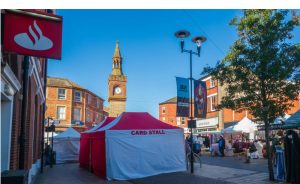
Image: Pete Stuart/Shutterstock.com
Ormskirk Market is notably one of the oldest in the UK. It has run almost continuously since it received its royal charter back in 1286. You will find it at Moor Street, Aughton Street, and Church Street on Thursdays and Saturdays from 8 am. Visit the town page about it to learn more. They have over 100 stalls on a good day. Ormskirk also has all the other main shops and plenty of fast food too including a McDonald’s last time we were there.
Where to eat in Ormskirk?
There are a few cafes in town, such as the Bagel Deli. You can enjoy Italian food in the Fat Italian, or head to Turquaz for a Turkish BBQ. There is a steakhouse in town, and many pubs to eat at.
Other Notable Attractions Nearby
If you are spending a couple of weeks in the area, you may want to explore. Here are some other sites in nearby towns that might wet your whistle:
- If you like churches, go and visit Ormskirk parish church while you are here. It’s not in another town, but it is like stepping back in time.
- Check out Lytham St Annes, it’s like a quiet version of Blackpool and great in summer.
- Visit Nelson, home of the Jelly Baby.
- Pretty Preston is a nice place to spend time.
- Go see Bolton, made famous by Flemish weavers.
- There’s always Morecambe, too, should you love the seaside.
There is always something to do in Lancashire. Check it out and see for yourself.
How to get to Ormskirk?
Finally, here are the travel details to get to Ormskirk. Remember – we are not good at directions.
By Road
Head north until the M6 then turn west on the M58. You will end up nearby.
On The Train
Ormskirk is on the Mersey Line.
By Air
The nearest international airport is Liverpool John Lennon.
By Sea
Alas, me hearties, yes are landlocked.
Got Five Minutes?
If you enjoyed our article and would like to read more, head to our website. It’s full of articles just like this one. Otherwise, give us a follow on Facebook, we want to go viral one day and every vote counts.
Header Image: Pete Stuart/Shutterstock.com

